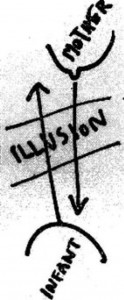‘Introducing a radically innovatory paper to the British Psychoanalytical Society in 1945, Donald Winnicott said: “I shall not first give an historical survey and show the development of my ideas from the theories of others, because my mind does not work that way. What happens is that I gather this an that, here and there, settle down to clinical experience, form my own theories, and then, last of all, interest myself to see where i stole what. Perhaps this is as good a method as any.”
In the first sentence he refuses to comply with the way psychoanalytic papers are conventionally organized. He assume influences are at work – “I gather this and that, here and there” – and he takes it for granted that in forming his own theories he will discover an indebtedness. he does not, it should be noted, refer to borrowing (on which subject psychoanalysis has been silent) but to stealing. In his unique theory of delinquency, which he calls the anti-social tendency, Winnicott suggests, as we will see, that the child steals in symbolic form only what once belonged to him by right. The child is unwittingly trying to make up for a deprivation he experienced in the original commonwealth of his relationship with the mother, and he is alerting the environment to this face. For Winnicott the anti-social act, like a regression in psychoanalytic treatment, is a return to the point at which the environment failed the child. He returns to find where what he hasn’t got has come from, to find the gaps in himself. Winnicott’s method of writing papers, so recognizably close to ordinary experience, enacts this process.’


